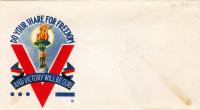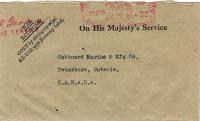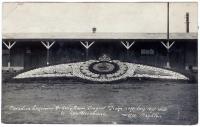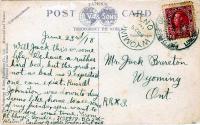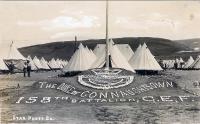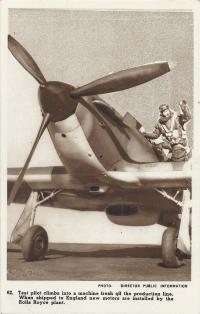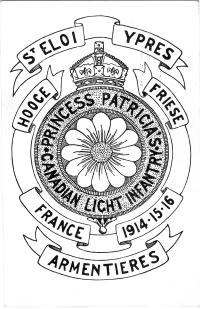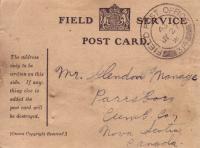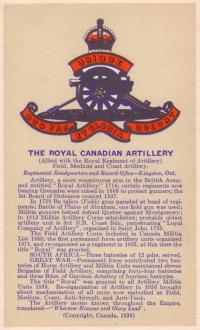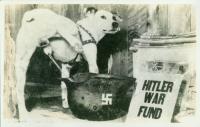Correspondence
Patriotic stationery
There were countless varieties of specialty envelopes available during the Second World War, like this one bearing the famous Morse code V for Victory.
War economy - save paper!
This government-issue envelope encouraged the user to slit the top carefully, so it could be reused as a way to save paper.
The Canadians at Seaford
During the First World War, it was customary for a unit to decorate the entrance to its encampment, like these at Seaford, on the south coast of England. One design, by Corporal Stenhouse of the Canadian Engineers, was forty feet long and ten feet wide. Another display marked the headquarters of the Canadian Army Service Corps.
The life of a conscript, 1918
Elroy Goudie of Petrolia, Ontario, described to a friend the military camp at Carling Heights, in London, just five days after he was conscripted in June 1918.
Training at Vernon, British Columbia
During the First World War, it was customary for a unit to decorate the entrance to its training encampment, as these images from Vernon, British Columbia, show. The 158th Battalion was from Vancouver, the 172nd Battalion from Kamloops, and the 131st and 121st Battalions from New Westminster, British Columbia. The card showing the 172nd Battalion camp was mailed in August 1916 by Leonard Adams of Pentiction, who was killed in action at Vimy Ridge in April 1917.
Fighting on all fronts
These postcards of Canadians in uniform during the Second World War used official government photographs provided by the Department of Public Information.
The Princess Pats
This postcard honoured Princess Patricia's Canadian Light Infantry, the first Canadian unit to enter the front lines during the First World War.
Field Service Postcard
The Field Service Postcard came into use during the First World War, as a way to speed mail delivery by reducing the time needed for censorship.
Badges of Canadian units
William Scully Ltd., a Montreal manufacturer of military badges, issued this series of regimental postcards early in the Second World War: Royal Canadian Artillery; Canadian Grenadier Guards; 6th Duke of Connaught's Royal Canadian Hussars; Royal Canadian Corps of Signals; Royal Montreal Regiment; Loyola College Contingent, Canadian Officers' Training Corps; McGill University Contingent, Canadian Officers' Training Corps; Les Fusiliers Mont Royal; Royal Canadian Air Force; Royal Canadian Army Service Corps; Corps of Royal Canadian Engineers; Regiment de Maisonneuve; Le Contingent de l'Univer
Give to the Hitler War Fund
This card is typical of the irreverent humour favoured by soldiers during the Second World War.

